OCZ PC4000 2GB EB Platinum Ed.
Oct 28th, 2005 | By Archive
OCZ PC4000 2GB EB Platinum Ed.
Date
: 10/28/05 – 05:55:31 AM
Author
:
Category
: Memory
Page 1 : Index
Manufacturer:
OCZ Technology
Price:
$330USD Monarch Computers
OCZ certainly needs no introduction here at Overclockers Online or anywhere else for that matter. In August of 2000, the memory market changed forever with the inception of OCZ. Enthusiasts finally had a company that was willing to provide everything we demanded out of our memory and provided the best customer service on the block to boot. Since 2000, nothing has changed and OCZ is still doing what it does. They continue to develop the best memory around and their customer service is second to none.

Today, I have the pleasure of looking at one of the newest memory kits that OCZ has unleashed on us, the 2 x 1024MB PC4000 Enhanced Bandwidth Platinum Edition kit that boasts the tightest timings to date for a 2GB pair running DDR500 @ 3-3-2-8. We all know the importance of the tight timings when dealing with the A64 on-die memory controller and OCZ is diligent in putting together 2GB kits with timings as tight as possible. Recent and upcoming games like Battlefield 2 and FEAR will no doubt benefit from 2GB so more and more people will be looking to upgrade from a 2 x 512MB kit. We will start out nice and easy with a quick look at the modules in question first.
Page 2 : Package
If you have ever seen OCZs Platinum or Gold series modules before, heck even their Premier series, then you are well aware that a fancy package is not necessary to entice buyers.

The elegant copper heatspreaders help the modules sell themselves and OCZ knows this, so they opt for a simple plastic package with the modules clearly visible for all eyes to see and drool over.
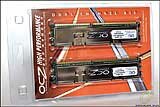
The big OCZ label stretched across the top of the cardboard insert is also a big selling point. With that OCZ name comes quality and 'High Performance' that is well known amongst all enthusiasts and overclockers alike. Down the side here on the front is the Dual Channel Label exclaiming that this pair of modules have been hand tested to run as a matched pair in dual channel mode.
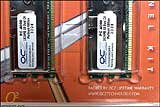
The cardboard insert is a generic one used on a number of other modules and OCZ is able to do this because they label each and every module with a sticker seen above. This sticker provides the speed, size, part number, series and timings of each module. You will also notice on the lower right hand corner where OCZs warranty is outlined, you will not see the word limited anywhere.
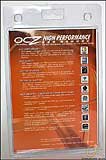
The backside is where OCZ take a little time to toot their own horn and rightfully so, they earned the right to. They outline the features of their memory covering the performance, quality, and technical support aspects, as well as discussing the lifetime warranty on all modules they sell, that's right,
lifetime
warranty.

The last note I will make about the packaging before taking a look at the specifications of these great looking modules is the fact that the package can be used multiple times for storage. The plastic package is held together with two buttons up top which are easy to open and secure again. Its a small detail but one that I appreciate.
Page 3 : Specifications
Specifications for memory are not that abundant and, in all honesty, half of the specifications we have already seen on the sticker on the modules. Here is the complete list of specifications pulled from the OCZ web site.
- 500MHZ DDR
CL 3-3-2-8
Also available in a 1GB Module
Unbuffered
Mirrored Platinum Copper Heatspreader
Lifetime Warranty
2.8 Volts
184 Pin DIMMSpecial Features
EVP® – (E)xtended (V)oltage (P)rotection. This is a novel OCZ voltage protection feature that allows modules to handle higher voltages. OCZ EVP® protected modules can tolerate VDIMM voltages up to 3.0V ± 5%. All EVP® protected modules are covered under OCZs Lifetime Warranty if overvolted within EVP® tolerances.
ULN2 – (U)ltra (L)ow (N)oise. This is a technology that uses various printed circuit board (PCB) techniques to reduce the amount of electrical noise that is present in all high-speed ICs. This results in faster and more stable memory.Part Numbers
2GB (2×1024) D/C Kit PN OCZ5002048EBPE-K[/quote]
I like OCZ's web site because it provides all the information I want to know about its modules on a single page in an easy to read manner. They also talk about each module and this is what they have to say about the PC4000 2GB kit we are looking at today.For the first time, the OCZ PC-4000 Platinum EB series combines the advantages of high density 1024MB modules with the unparalleled performance advances of low timings, delivering enthusiasts and gamers what they want most from DDR memorysuperior performance across the complete array of graphic intensive applications and game titles. Unlike no other 2GB memory solution, this cutting-edge line operates with the extraordinarily fast latency timings of 3-3-2! [/quote]
OCZ is excited about this kit, I am excited about this kit, and you should be excited about this kit so let's keep this show moving and have a look at these beautiful modules.
Page 4 : Package ContentsWe have already seen everything that is in the package and that is two sticks of memory modules.

Even behind the clear plastic, the heatspreaders glistened in the light and, once escaped from the clutches of the breathless plastic, the modules are blindingly reflective with their platinum finish.

The big OCZ label smack dab in middle, both front and back, is what lets you know who these modules are produced by. Aside from these logos tattooed to the middles and the sticker with the modules information, there are no other markings or identifiers on OCZ RAM.
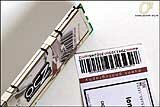
I touched on the reflective finish of the platinum heatspreaders earlier and the photo here backs that up. My business card is readable in the reflection, it is that mirror like. So ladies, if you are ever in an emergency situation that requires a mirror, you can dip into the computer case if you are running a set of platinum OCZ.

Removing the heatspreaders voids the warranty. That is why I am doing it right now, so you don't have to! Being able to identify the ICs and PCB can sometimes assist in gauging the overclockability of the modules. Thats why we will be taking them off. That and I just like taking stuff apart to see what's inside.
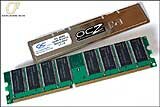
After what seemed like a two hour battle that cost me three finger tips and a couple broken nails. I finally got the thermal tape to let go and reveal what is powering this dual channel kit without so much as a scratch to the heatspreaders. Despite the fact that the thermal tape only contacts a portion of the ICs and not the entire surface, the heatspreaders are stuck on there like peanut butter to the roof of your dry mouth.
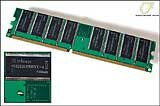 Infineon HYB2D512800CE-6 on Brain Power PCB[/quote]
Infineon HYB2D512800CE-6 on Brain Power PCB[/quote]
This is what I was able to dig up about the ICs from the Infineon site:HYB25D512800CE-6 / 512Mb,64Mx8, DDR333 2.5-3-3 / PG-TSOPII-66[/quote]
Clearly these specifications do not match up to what we will be expecting so I contacted OCZ to find out the actual specifications and, as expected, they wouldn't release any information. This just means that we must not hold much stock in what we see on these chips and will reserve judgement until we see how they perform. This is obviously that vulcan grip thermal tape that holds these heatspreaders firmly in place.[/quote]
This is obviously that vulcan grip thermal tape that holds these heatspreaders firmly in place.[/quote]
With quality heatspreaders to help cool these impressive ICs, we should be able to see some impressive results with this 2GB Enhanced Bandwidth Platinum Edition kit. The Venice core is warmed up and ready to roll, so I will now be installing the DIMMs and doing some overclocking as that is what we do best here at Overclockers Online.
Page 5 : Installation & OverclockingInstalling memory modules is simple and straight forward. OCZ memory is no different than any others and the heatspreaders they use on their modules do not introduce any issues. The heatspreaders do not add any bulk to the memory so I do not anticipate any issues coming up when installing the OCZ 5002048EBPE-K kit. I will be using the following components for overclocking and testing of this memory:
Asus A8V-E Deluxe
AMD64 3000+ Venice core
Asetek VapoChill Micro
HIS X800GTO IceQ II
Antec Smart Power 450W v2.0
Antec Take 4
WD Raptor 10,000 RPM SATA
Windows XP Pro x64 + Latest UpdatesMemory:
OCZ PC4000 Enhanced Bandwidth Platinum Ed.2*512 OCZ PC3200 Premier Dual Channel[/quote]
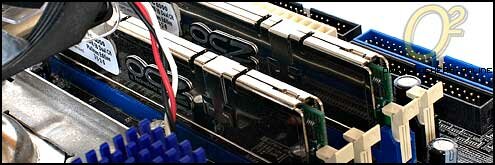
As I expected, the two modules slide in and lock in place without issue. Despite this 2GB kit being rated for DDR500 speeds, we all know it will run faster, but how much is yet to be determined. To overclock RAM, I like to boot into Memtest86 and run a couple passes at each stage until an error pops up. I then double check the stability in windows by running 32M digits in SuperPi, a couple runs of 3DMark 01SE, and Prime95 on torture test blend for a solid 6 hours. Before doing any overclocking or testing, the memory was ran through 24 hours of Passmarks BurnInTest Pro and 24 hours of Memtest86.

The first thing I wanted to do is see what timings I could get out of the kit at DDR400. The photo above illustrates that the highest frequency I was able to run at the tight timings of 2-3-2-7 (CAS-tRCD-tRP-tRAS) was 227MHz for an effective speed of DDR454. The ‘specifications’ of the ICs provided the anticipation that at some degree we could run CAS 2.
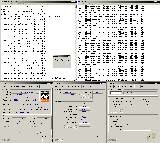
At 275 with 3-3-2-7 timings, the memory ran smooth like butter churning through 5 passes of Memtest86, a couple runs of 3DMark 01SE, and a 32M run of SuperPi with Prime95 chugging along in the background for some time on torture test blend. That definitely constitutes a stable overclock in my eyes.
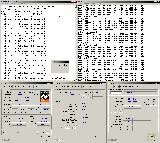 I was able to repeat the process at 285 with 3-4-4-10 timings.[/quote]
I was able to repeat the process at 285 with 3-4-4-10 timings.[/quote]
Here is the chart with all my stable results I could muster out of this impressively flexible 2GB kit:

You have a wide arrange of options with this fine offering from OCZ; from tight timings at DDR425 to a decent DDR570 at the high end with looser timings. As you may have noticed, this kit will also run at 2.5-3-2-7 at the stock frequency of DDR500 which was a bit of a surprise. I will also mention that when the memory is set to default in the Asus A8V-E Deluxe it would run the RAM at timings of 3-3-2-7 and not 3-3-2-8 that the RAM is advertised at, so OCZ is being quite modest with the advertised timings. The last column shows no more than 2.7v being used in overclocking. I tried up to 3.0v when 2.7v caused errors with no benefit. Having to get all of this performance with only 2.7v is very impressive and ensures that any and, pretty much, all motherboards will be able to take advantage of the frequencies and timings found here.
The one disappointment came when I had to switch to a 2T command rate from 1T. I don't feel this is a limitation of the RAM in any way but more of a problem with the CPU or motherboard I am using for this review, despite the Venice core CPU having the Rev. E on-die memory controller which is suppose to have the better memory controller for handling a large amount of RAM like this. I did try the kit in the Foxconn Winfast NF4SK8AA-8EKRS with similar results and the Foxconn board uses the NVIDIA nForce 4 chipset while the Asus motherboard in the review uses the VIA K8T890 chipset so that is why I am leaning on the CPU being the culprit.
It is now time to see how the performance varies from the two ends of the spectrum running various test beds.
Page 6 : PerformanceFor testing performance of memory, we are obviously going to be using an array of software to gauge the bandwidth including Everest Ultimate Edition, SiSoft Sandra, and the memory testing suites of PCMark 04 and 05. Super PI of 1M digits will also be ran to gauge the performance as the frequency increases. The last program I will run is another Futuremark program, 3DMark 01SE. The original 3DMark is still one of the favorites amongst overclockers as it calculates its score from total system performance and not just the 3D graphics performance. In addition to the synthetic benchmarks run, I will also be using BenchEmAll to run both Half-life 2 and Far Cry for some real world results of the performance at the various frequencies that I could get this memory to run at. All benchmarks were run 1:1 with the CPU and repeated three times with the average of the three being plotted. Let's get started and look at the results:
SiSoft Sandra Memory Bandwidth
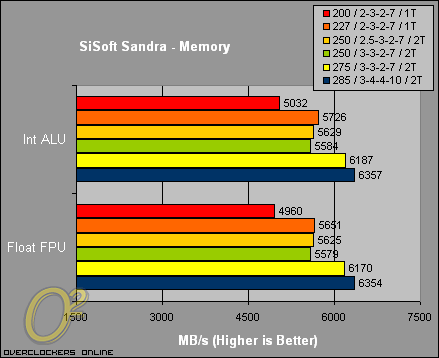
Everest Memory Bandwidth

Everest Latency
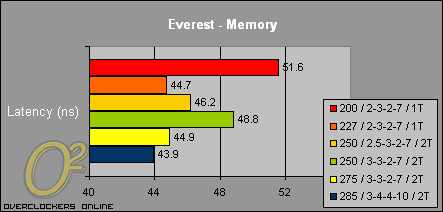
Futuremark PCMark 04/05 Memory Suite
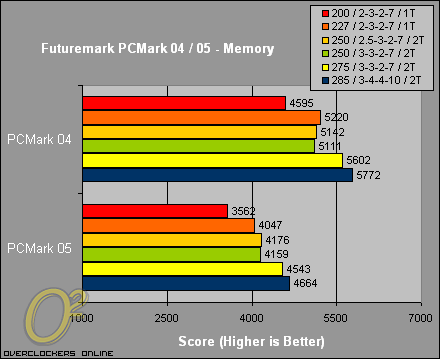
Futuremark 3DMark 01SE

SuperPi 1M Digits
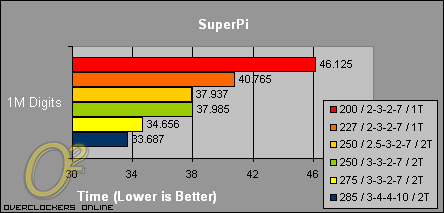
Clearly the performance for the most part increases with higher frequencies but on occasion at certain frequencies tighter timings provided greater bandwidth and/or lower memory latency. Now here are the results of the gaming benchmarks:

Having memory that will run 1:1 with the CPU as it is scaled up agrees with the games; the FPS steadily rises with each step of the way. Next up is a little comparison I decided to do to see the difference between 1GB and 2GBs of RAM.
Page 7 : 1GB vs 2GBThis is not your normal comparison that you will find in a review, but I felt this was a valid way to see how much of a potential advantage 2GB of RAM will be when compared to 1GB in applications that can utilize the extra memory. To do this I used my OCZ PC3200 Premier Dual Channel kit and used the same frequency, timings, and command rate with both kits running in dual channel mode. The comparison will be within Adobe Photoshop CS2 running my normal batch after photographing a sporting event.

100 RAW images will be opened from a separate hard drive than the one running the OS. These images will be converted from RAW into Photoshop using the built in ACR software. Once the 100 RAW images have been converted for manipulation in Photoshop, they will then run through my standard workflow action set which involves a levels adjustment, unsharp mask at varying settings, a run through Noise Ninja using the Photoshop plug-in, then resized and converted for web use with file info and another shot of USM after resizing. Finally the files will then be saved in JPG format to the hard drive in which they were originally pulled from. The whole process will be repeated three times with an average being recorded for the results. Let's have a look at the results:
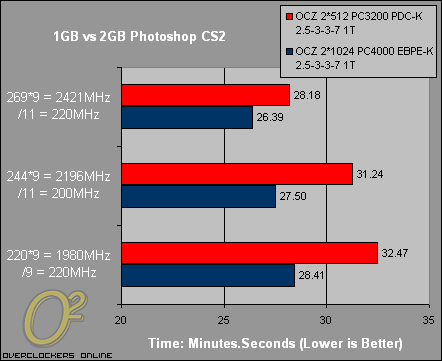
To be honest, I was expecting a little more of a gap between the two kits of RAM, but a 10% increase in performance is still impressive for the 2GB pair. At the highest CPU frequency, the difference is not as much but still around 7%. Now I understand that these are two different types of RAM but it was the closest I could get to a direct comparison between a 1GB and 2GB kit. Photoshop definitely has a little more spunk and less lag when you have multiple large files open. With the performance benefit, the usability with 2GB is an added bonus. I will now be wrapping up this look at the PC4000 2GB Enhanced Bandwidth Platinum Edition kit from OCZ in the conclusion.
Page 8 : ConclusionUntil recently, 2GB of RAM was considered to be overkill for most systems. Design professionals, video editors, programmers, and servers can use as much memory as you can throw at them but for the common personal computer user, it was never needed. Gamers never had a need for that much memory and preferred smaller 2*512MB kits that run in dual channel, and with AMD64 owners, nice and tight timings. This provided the best performance but now, OCZ has gone and turned the tables offering us PC4000 2GB kits that run at timings of 3-3-2-8. This now gives timings almost as tight as 2*512GB kits opening the door to a lot more 2GB kits making their way into a computer case near you.
As you saw from the overclocking, this kit not only runs DDR500 @ 3-3-2-8 but it actually runs DDR500 @ 2.5-3-2-7 and 2-3-2-7 up to DDR450+. Aside from the little issues with running at a command rate of 2T vs 1T, which I consider to be an issue with the CPU/motherboard I was using and not the RAM, this memory does some amazing things. In my Photoshop CS2 comparison there was an excellent 10% gain in a standard photo editing workflow when put up against a 2*512MB kit at the same frequency and timings. This RAM also had no problem running up to DDR570 when I loosened the timings to 3-4-4-10, all without requiring over 2.7v.
Gone are the days when the best performance is provided by 1GB kits of memory. OCZ has given us an alternative that provides amazing performance, solid overclockability, and 2GBs of memory in the form of two 1GB modules running in dual channel at timings that are un-heard of anywhere else on the market. Did OCZ hit a grand slam in the bottom of the ninth with this PC4000 Enhanced Bandwidth Platinum Edition 2GB kit? Not quite, but it certainly was a lead off homer to get the team off to an early lead and that deserves my Editors Choice Award.

Advantages:
- Versatile frequency and timings
- Solid overclockability
- Minimum voltage to maximize performance
Disadvantages:
- Not all CPU/Motherboard combinations can handle 2GB at 1T
- If you want to play you have to pay
Overclockers Online would like to thank OCZ for providing this kit for review.
Leave Comment
You must be logged in to post a comment.